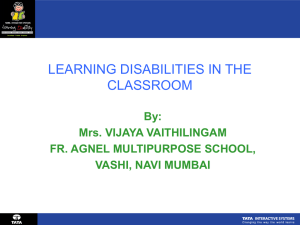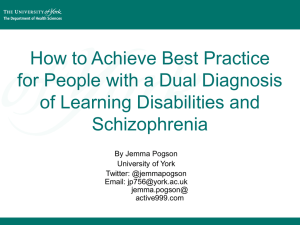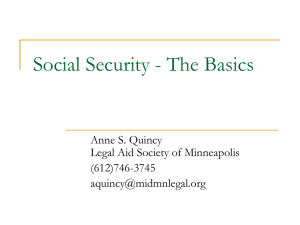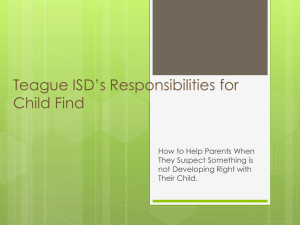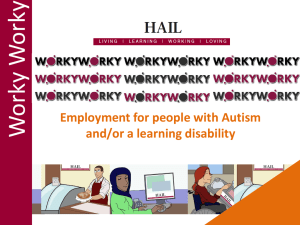Defining Your Pathway to Employment
advertisement
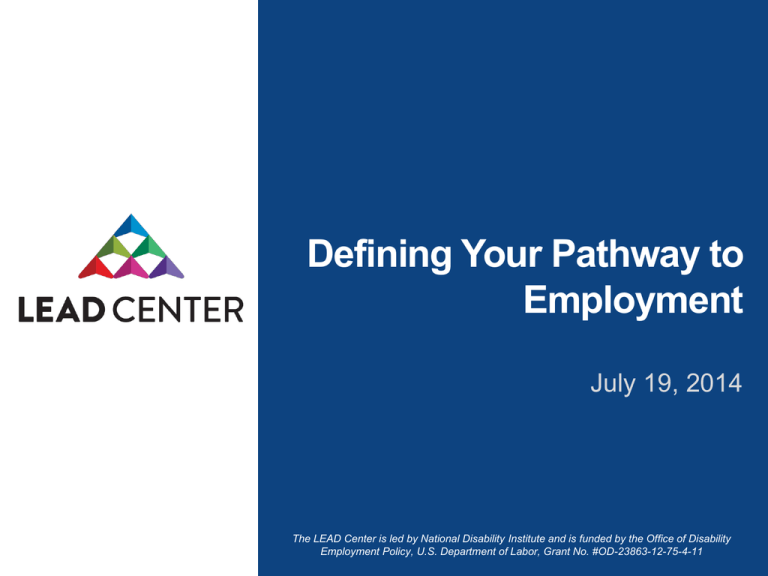
Defining Your Pathway to Employment July 19, 2014 The LEAD Center is led by National Disability Institute and is funded by the Office of Disability Employment Policy, U.S. Department of Labor, Grant No. #OD-23863-12-75-4-11 NATIONAL DISABILITY INSTITUTE A national research and development organization with the mission to promote income preservation and asset development for persons with disabilities and to build a better economic future for Americans with disabilities. LEAD CENTER MISSION To advance sustainable individual and systems level change that results in improved, competitive integrated employment and economic self-sufficiency outcomes for individuals across the spectrum of disability. 3 The National Center on Leadership for the Employment and Economic Advancement of People with Disabilities (LEAD) is a collaborative of disability, workforce and economic empowerment organizations led by National Disability Institute with funding from the U.S. Department of Labor’s Office of Disability Employment Policy, Grant No. #OD-23863-12-75-4-11. This document does not necessarily reflect the views or policies of the U.S. Department of Labor’s Office of Disability Employment Policy, nor does the mention of trade names, commercial products, or organizations imply endorsement by the U.S. Government. 4 FRAMING THE ISSUE People with disabilities live in poverty at a rate twice that of their non-disabled peers. (28.4% compared to 12.4%) In December, 2013, 15.9 million working age adults with disabilities received Social Security Disability benefits.* 5 THE CHALLENGE The presence of a disability and the need to maintain a public benefit should not require you to forfeit your economic stability and live in poverty. Without knowledge and guidance, you are not empowered to earn, learn, save and build toward the financial future you want for yourself. 6 TODAY’S GOAL To equip you with the information you need to make more informed decisions and support your highest expectations for yourself and your rights to equality of opportunity and participation in the economic mainstream. 7 STRATEGIES Financial Education Budgeting Credit Repair Benefits Planning Employment Use of Work Incentives Use of Tax Incentives Earned Income Tax Credit Individual Development Accounts Trusts/Pooled Trusts Family Self-Sufficiency Programs Ways to Work Retirement Accounts** Assistive Technology Loans Student Loans Medicaid Buy-In Post-secondary education Self-employment Micro-Enterprise Home Ownership The Life You Want Work Incentive Planning & Assistance, Protection and Advocacy, Taxpayer Advocates, Volunteer Income Tax Assistance, My Free Taxes, Credit Counseling 8 8 ACCESSING EMPLOYMENT SERVICES 9 DOORWAYS TO EMPLOYMENT State Vocational Rehabilitation Agency Department of Labor – One Stop Centers Home and Community Based Services Independent Living Resource Centers SSA Ticket to Work Program Federal Hiring of People with Disabilities Section 503 10 STATE VOCATIONAL REHABILITATION (VR) The VR program is a state-federal partnership that promotes the employment of people with disabilities. VR counselors have extensive specialized training to work with you to: Identify your employment goals Provide assessments to measure your skills and aptitude Provide access to assistive technology and other employment supports Find your VR office - http://askjan.org/cgi-win/typequery.exe?902 11 AMERICAN JOB CENTERS Available in every community to provide employment, education and training services all in one place. American Job Centers offer a range of services – some of which are available to all job seekers and some which require meeting eligibility requirements. Online resources are available to find a job, create or update a resume, better understand networking, and assess your transferrable skills at http://jobcenter.usa.gov/find-a-job. To learn more and/or locate an American Job Center near you, http://www.servicelocator.org/ 12 DISABILITY EMPLOYMENT INITIATIVE The Disability Employment Initiative (DEI) is funded through a contract with the Department of Labor to States to improve education, training, and employment opportunities and outcomes of youth and adult job seekers with disabilities. DEI Projects hire staff with expertise in disability and workforce development to serve as Disability Resource Coordinators (DRCs). To see if your state is a DEI grantee: http://www.doleta.gov/disability/DEI.cfm 13 HOME AND COMMUNITY BASED SERVICES Home and Community Based Services provide opportunities for Medicaid beneficiaries to receive services that support their living in the community. These programs serve targeted populations a state chooses to serve under a Medicaid Waiver program. 14 INDEPENDENT LIVING CENTERS Centers for Independent Living (CILs) are grassroots, advocacy-driven organizations run by and for people with disabilities. Independent Living Centers have four core services, 1. Individual and Systems Advocacy 2. Information and Referral 3. Peer Support 4. Independent Living Skills Training ** Many offer Benefits Planning and Employment services.** To locate an Independent Living Center near you: http://www.ncil.org/directory.html 15 SSA TICKET TO WORK PROGRAM SSA’s Ticket to Work program provides you an opportunity to shop around for the return to work services you may need. When you use a participating Employment Network (EN), you receive services, support and Continuing Disability Review (CDR) protections from SSA. The EN you choose will receive payments as you work and earn at certain levels. To better understand or to locate an EN: http://choosework.net/ 16 FEDERAL HIRING OF PEOPLE WITH DISABILITIES The Federal government provides employment opportunities for individuals with disabilities through Schedule A hiring. Schedule A is a hiring authority available to federal agencies to hire individuals with disabilities without competing for the job. To learn more: http://www.opm.gov/disability/PeopleWithDisabilities.asp http://www.dol.gov/odep/pubs/scheduleA/abc_Job_Applicants_ ODEP_508%20compliant.pdf 17 SECTION 503 Section 503 prohibits federal contractors and subcontractors from discriminating in employment against individuals with disabilities and requires these employers to take affirmative action to recruit, hire, promote, and retain these individuals. The new Section 503 regulations strengthen the affirmative action provisions of the regulations. The new regulations establish a nationwide 7% utilization goal for qualified individuals with disabilities. Individuals with disabilities are now asked to self-identify. http://www.dol.gov/ofccp/regs/compliance/section503.htm 18 LEADING YOUR RETURN TO WORK 19 DISCOVER WHO YOU ARE Your Employment Search starts with You – not a case manager or employment counselor or even an Employer. Through a process called DISCOVERY, you can gain a better understanding of your contributions, interests, and conditions. 20 CONTRIBUTIONS Contributions are what you are offering an employer. Your skills Your education Your unique knowledge Your personality traits Your abilities Make a list of all your contributions. 21 CONTRIBUTIONS, CONT. If you are having difficulty thinking about all that is great about you: Interview people who know you and are positive about you working and your work, Ask them what they see as your contributions and write down what they say, If you do not want to ask anyone – write down all the duties you had in jobs/school/volunteering that you did well, or Make a list of the positive things people have said about you. 22 MATCHING CONTRIBUTIONS TO EMPLOYERS Once you have your list of contributions… Write down what types of employer might need those contributions, And what employers might have the type of environment that brings out your best. Add to your list as you think of different employers. 23 INTERESTS An interest is something that is strong enough to make you want to go to work each day. It is not just something you know how to do. Learning about computers, landscaping, working on machines, music, drawing cartoons. Think in broad categories and employers who have a need for that interest. 24 TASKS Tasks are the different pieces or duties that make up a job. Employers bundle tasks together into job descriptions. By unbundling tasks it is easier to see portions of jobs that meet your contributions. It is also easier to see employer needs when job descriptions are unbundled into tasks. 25 TASKS Write Down tasks you want to do for pay. What interests you want to use in a job. Think of employers who might have those tasks and could use your interest. Add those employers to you employer list. 26 CONDITIONS What brings out the best you have to offer at Work? When it occurs – Time What you do – Tasks Interactions – people, email, phones Pacing – speed Environment – outside, inside, noise, quiet Expectations – supervisor, co-workers, customers 27 CONDITIONS It is important to think carefully about conditions: They are elements you need to be successful. They are deal breakers, if a job does not meet your conditions you can not accept that job. They are not elements that you want or would be nice to have - those are preferences. Make a list of your conditions - Think about why those are your conditions? Can an employer meet your conditions? 28 CONDITIONS VERSUS PREFERENCES Once you have created a list of conditions you can create a list of preferences. It is a good idea to prioritize your preferences. Think about what your trade offs are in regards to preferences. Also keep in mind what you are offering the employer. 29 SET PRIORITIES Think about what is most important to you. Wage: how much you earn. Type of work: what you do at work. Environment: the culture of the workplace. Co-workers: who you work with. Location: where you work / ease of commute. Flexibility: the employers ability to meet your unique needs. Remember your priorities may change over time 30 DISCLOSURE What information will you share about your accommodation needs/disability and when? If someone is helping you find a job what can they say about your disability or other sensitive information? Think about what you feel is reasonable to share and what is not. Best Practice: Frame accommodation needs in terms of contributions you have to offer and how supports from the employer will make you even more productive. 31 PULLING INFORMATION TOGETHER By knowing your contributions, interests, and conditions of employment, you can focus on employers that need your contributions and meet your conditions and priorities rather than randomly applying for jobs. If you are having someone help you find a job, bring your information to that person. 32 YOUR NETWORK Think about who you know that works at a business you are interested in working at. Ask them if you can use their name or will they set up an informational interview for you. 33 YOUR NETWORK, CONTINUED What businesses do you or your family frequently use in your community for groceries, clothing, auto repair, home services and other purchases? Are you interested in working at any of these places? Do you or your family know anyone who owns a business? Are they willing to network for you? 34 UNDERSTANDING YOUR SOCIAL SECURITY BENEFITS 35 OVERVIEW OF SSA’S DEFINITION OF DISABILITY The Social Security Administration has two programs to support individuals with disabilities who are not able to work and earn at a substantial level. Social Security Disability Insurance (SSDI) Supplemental Security Income (SSI) Both SSDI and SSI have work incentives available that make it possible for individuals to test their ability to work and continue to receive some or all of their cash and health benefits. 36 SSA ELIGIBILITY Individuals must prove 2 things to be eligible for SSDI or SSI: 1. Prove that they have a documented medical disability that will last 12 months or longer or result in death. 2. Meet SSA’s definition of disability: The inability to engage in Substantial Gainful Activity (SGA, which is paid work) by reason of any documented medical impairment (physical or mental) that will lasts 12 months or longer and/or result in death. 37 SUBSTANTIAL GAINFUL ACTIVITY (SGA) SGA is a basic test used by SSA to establish disability status. SGA is the performance of significant mental and/or physical duties for profit. It is usually determined to be gross earnings (before taxes) of an amount of money that is set January 1 of each calendar year based on the National Average Wage Index. To meet this test a person must not be working, or if working, earning less than the SGA level amount. 2014 SGA for non-blind individuals = $1070/month 2014 SGA for blind individuals = $1800/month 38 ELIGIBILITY OF BENEFITS - SOCIAL SECURITY DISABILITY INCOME - SSDI SSDI benefits are based on a person’s work history (F.I.C.A. taxes). SSDI check amount will vary from person to person. DAC –Disabled Adult Children Disability Prior to Age 22 Not Legally Married Insufficient FICA or higher parent amount Parent’s record is open (Deceased, Disabled, or Retired) Medical Insurance – MEDICARE 24 month waiting period upon eligibility Part A-Free, Part B/D-Premium 5 Month Waiting Period for cash benefits to start No asset limit SSDI pays close attention to SGA 39 ELIGIBILITY OF BENEFITS - SUPPLEMENTAL SECURITY INCOME - SSI SSI benefits are for individuals with a disability or over age 65 with limited income and resources Income less than $721/month ($1082/month/couple) in income. Unearned Income (Not Wages) SSDI, VA, Annuities Deemed income Spouse to spouse Sponsor to alien Parent to child (if under age 18) In-kind Support (1/3 deduction of SSI check) Earned Income (Wages) SGA is a factor during initial eligibility only Resources (NOT Wages or Unearned Income) $2,000/Individual, $3,000/Couple Medical Insurance – MEDICAID WORK INCENTIVES COMPARISON CHART Social Security Disability Insurance Trial Work Period Extended Period of Eligibility Impairment Related Work Expense Subsidies Unsuccessful work attempt Unincurred Business Expenses (self-employed only) Continuation of Medicare Section 301 Expedited Reinstatement Ticket to Work Medicaid Buy-In Supplemental Security Income Student Earned Income Exclusion Impairment Related Work Expense Blind Work Expense 1619 (a) 1619 (b) Property Essential For Self Support Plan for Achieving Self-Support Subsidies (only at time of application) Section 301 Reinstatement without new application Expedited Reinstatement Ticket to Work Medicaid Buy-In CONTINUED MEDICAID UNDER 1619 (B) For those who receive SSI only: Loss of SSI check due to earned income Remain disabled Assets under $2000 ($3000/couple) Need Medicaid to work Have been eligible for SSI for at least one month Annual earnings below the State Threshold Amount http://www.ssa.gov/disabilityresearch/wi/1619b.htm An individualized threshold amount may be available. MEDICAID BUY-IN PROGRAMS Purpose of the Program: To provide an opportunity for persons with disabilities who are working the opportunity to purchase Medicaid coverage. Sample Eligibility Criteria: 1. Between the ages of 16 and 65 2. Have a permanent disability 3. Be employed (full or part time) 4. Meet the income and asset guidelines To locate a Medicaid Buy-in program, check with your State Medicaid office. Based on the rules of your State, you may also be able to use the Medicaid Buy-In program to supplement your Employer’s coverage. 43 SUPPORTS TO ASSIST YOU Work Incentive Planning and Assistance Community Work Incentive Counselors provide the following at no cost: Work incentives planning and assistance; Help beneficiaries and their families determine eligibility for Federal or State work incentives programs; Refer beneficiaries with disabilities to appropriate Employment Networks or State VR agencies based on individual needs and impairment types; and Provide general information about health benefits coverage available to beneficiaries once they enter the workforce http://www.choosework.net/ 1-866-968-7842 / 866-833-2967 (TTY/TDD) SUPPORTS TO ASSIST YOU Protection and Advocacy Advocates are available to provide assistance with the following at not cost: Access to Community Services Special Education and Transition Transportation , Housing, Health Care Disability Benefits and Work Incentives Rights and Conditions of employment Vocational Rehabilitation and preparation Rights, Responsibilities, and Reasonable Accommodations under the ADA Wage and hour issues Assistance with removing barriers to a beneficiary’s return to work goal http://www.choosework.net/ 1-866-968-7842 / 866-833-2967 (TTY/TDD) SUGGESTED NEXT STEPS 1. Discover yourself. Use the tools provided to identify your contributions, interests, and conditions. 2. Meet with a Benefits Planner to better understand your Social Security Disability benefits. http://www.choosework.net/ 1-866-968-7842 / 866-833-2967 (TTY/TDD) 46 SUGGESTED NEXT STEPS 3. Explore the doors to employment available to you. Keep in mind that you may need to meet eligibility requirements and/or register. If one door closes, open another. State Vocational Rehabilitation Agency Department of Labor – One Stop Centers Home and Community Based Services Independent Living Resource Centers SSA Ticket to Work Program Federal Hiring of People with Disabilities Section 503 47 SUGGESTED NEXT STEPS 4. Tap into your Networks. Let people know you’re looking for work. Ask your friends and family who they know and share with them your goals. Request informational interviews. http://www.careeronestop.org/ResumesInterviews/Intervi ews/InformationalInterviews.aspx 5. Set a goal and a timeline to complete items 1, 2 and 3 and 4. 48 JOIN OUR LISTSERVES LEAD Center – http://leadcenter.us6.listmanage.com/subscribe?u=bb0c478f9803ed67c40eec568&i d=79c43d2d82 National Disability Institute’s REI Network http://visitor.constantcontact.com/manage/optin/ea?v=001Q CEETLfRg3ZGgDRWkkH9aQ%3D%3D THANK YOU Elizabeth Jennings National Disability Institute ejennings@ndi-inc.org LEAD Center - www.leadcenter.org National Disability Institute www.realeconomicimpact.org 50
